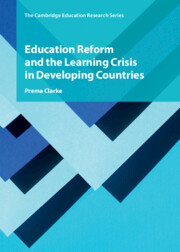Book contents
- Education Reform and the Learning Crisis in Developing Countries
- Education Reform and the Learning Crisis in Developing Countries
- Copyright page
- Contents
- Figures, Tables, and Boxes
- Acknowledgments
- Introduction
- 1 The Learning Crisis
- 2 Donor Programming in Education
- 3 Best Practice and Research in Education
- 4 Creating an Evidence Base for Learning
- Epilogue
- Index
- References
4 - Creating an Evidence Base for Learning
Published online by Cambridge University Press: 08 September 2022
- Education Reform and the Learning Crisis in Developing Countries
- Education Reform and the Learning Crisis in Developing Countries
- Copyright page
- Contents
- Figures, Tables, and Boxes
- Acknowledgments
- Introduction
- 1 The Learning Crisis
- 2 Donor Programming in Education
- 3 Best Practice and Research in Education
- 4 Creating an Evidence Base for Learning
- Epilogue
- Index
- References
Summary
The chapter begins by describing the content of the micro and meso levels that make up the ecosystem necessary to promote learning. In the past decades, knowledge generated on quality education has led to “discrete and disruptive” interventions with manageable and disaggregated components that fit into the worldview of the mostly distant donor (a “hawk’s eye” approach). An organically integrated approach is constructively worked out, which provides a framework for analyzing micro and meso levels (a “turtle’s feet” approach). The conceptual framework that structures this knowledge generation includes three areas that define micro and meso institutions: composite history, tangled milieus, and embedded mindsets. This research framework allows for the design and implementation of interventions that fit the ecosystem in a country that drives how things work on the ground. The chapter argues that such a shift in knowledge generation will help to design interventions that enable meso institutions to intervene for consistent and effective teaching and learning to take place in schools in developing countries.
Keywords
- Type
- Chapter
- Information
- Education Reform and the Learning Crisis in Developing Countries , pp. 152 - 193Publisher: Cambridge University PressPrint publication year: 2022

